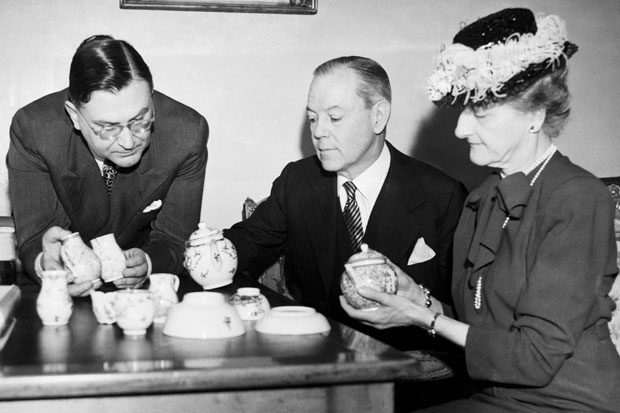Next time you’re in a shop that sells Chinese blue and white porcelain, pick up a piece and turn it over. Chances are good it will carry an inscription in blue on the bottom. Called a reign mark, it tells you which emperor ruled when the piece was made. As the last reign ended in 1912, the dish you’ve picked up should logically be at least a century old. Hundred-year-old porcelain selling for £2? Not likely, but hold that thought.
When you buy a Chinese dish today, you are doing what collectors have done since porcelain started arriving in London in Elizabethan times. Shakespeare mentions this marvel in Measure for Measure, when Elbow’s pregnant wife asks Mistress Overdone for stewed prunes. The brothel-keeper happens to have some in a threepenny dish, a fine dish but not, Shakespeare tells the audience, a ‘China-dish’. Mistress Overdone runs a profitable business, but not even she can afford Chinese porcelain. Within a generation, such ware was an affordable luxury.
Our taste for blue and white ceramics started in Persia, where potters decorated their low-fired wares with floral and abstract designs in cobalt blue. When Khubilai Khan conquered China in the 13th century, he brought the Persian taste to China, and Chinese manufacturers responded. Having recently developed the technology to produce true porcelain, they outdid the Persians. Chinese blue-and-white dazzled buyers everywhere and monopolised the high end of the market.
When potters elsewhere started to make cheap substitutes, the potters in Jingdezhen — the porcelain capital of China — responded by designing showy blue and white porcelains to sell at the lower end of the market. This was the style Europeans encountered when they arrived in Asian waters in the 16th century.








Comments
Join the debate for just £1 a month
Be part of the conversation with other Spectator readers by getting your first three months for £3.
UNLOCK ACCESS Just £1 a monthAlready a subscriber? Log in